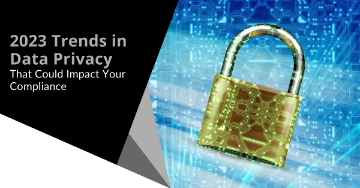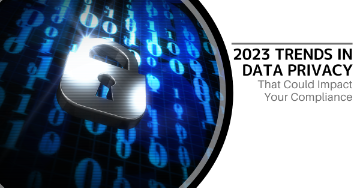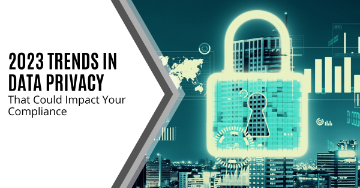-
Welcome to My Website
This is a text box. Write your own content here. This is an excellent place for you to add a paragraph.
2023 Trends in Data Privacy That Could Impact Your Compliance

2023 Trends in Data Privacy That Could Impact Your Compliance

คาดการณ์ว่าภายในปี 2024 ข้อมูลส่วนบุคคลของประชากรกว่า 75% บนโลกใบนี้จะต้องได้รับการปกป้องภายใต้นโยบายอย่างน้อย 1 นโยบาย และใน ทุกวันนี้กว่า 40% ของงานด้านเทคโนโลยีการจัดการนโยบายความเป็นส่วนตัว มีการนำ AI เข้ามาประยุกต์ใช้ เราขอเชิญคุณมาเรียนรู้ไปกับเรา เรื่องเทรนด์ล่าสุด ที่จะช่วยให้งาน compliance สำหรับองค์กรเดินหน้าไปอย่างปลอดภัยและสอดคล้องกับนโยบาย
Approximately 40% of privacy compliance technology needs artificial intelligence to operate. Learn how data privacy is evolving and how it could impact your compliance needs.



Data privacy has been a growing requirement ever since
the internet age began. So much personal information is flying around through
computer networks. Protecting it has become a mandate. Most companies must
follow HIPAA, GDPR, or another industry or locality-based privacy rule. By the
end of 2024, 75% of the world’s population will have their personal data
protected. It will fall under one or more privacy regulations.
You
don’t need to be a large enterprise organization to have data privacy
compliance at the top of your mind. It goes hand in hand with cybersecurity.
Additionally, privacy requirements hit all sized companies.
Between
July 2020 and July 2021, GDPR violations rose by 113.5%. The
number of associated fines also jumped, by 124.92%. Check out this link here, to
find out about some of the biggest fines for GDPR data violations.
It’s
important to make data privacy a priority and factor it into all your data
collection processes. When companies collect, send, or store personally
identifiable information (PII) it needs protection. This means putting adequate
safeguards in place.
To
stay on top of your privacy compliance obligations, you should also keep up
with trends in this area. Next up, we’ve documented the biggest data privacy
trends happening in 2023 that you should be aware of.
What’s Happening in Data Privacy Compliance?
AI Governance
Approximately 40% of
privacy compliance technology needs artificial
intelligence (AI) to operate. AI has certainly made its way into many of the
applications we use on a daily basis.
When
you’re typing in MS Word and text just springs up as a suggestion, that’s AI
predicting what you’ll type next. When working on a photograph in Photoshop,
you can now click a button to give a frowning face a smile. This is also the
work of AI.
So,
it’s no surprise that AI is running many of the algorithms responsible for
keeping data protected. But what happens when there is a problem with the AI?
This
is the question that AI governance is working to address. This is a new trend
in data privacy because AI has never been so prevalent throughout the data
journey as it is now.
Whenever
AI is used in the data protection area, organizations need to govern it
properly. This helps ensure that automated processes aren’t accidentally
exposing sensitive data.
Consumer Privacy UX
A
trend that we’ve seen over the last several months is putting more privacy
power into the consumer’s hands. Many privacy regulations require that apps and
websites provide data transparency. They need to tell people what data they’re
collecting, how they’re collecting it, and what they do with it. People also
need an “out” to get their data back.
These
needs have led to consumer privacy UX becoming a “thing.” You can think of this
as a centralized privacy portal. A place people can access privacy-related
settings in various apps. This gives better visibility into how their data is
being used.
Increased Scrutiny of Remote Employee Monitoring
The
pandemic has forever changed the global workforce. Many organizations are now
running completely remote offices. Or may be using a mix of remote and
in-office staff. The dramatic increase in people working from home has led to
data collection changes. Companies are ramping up their monitoring of those
employees working off-site.
But
this type of monitoring opens a can of worms when it comes to data privacy.
Organizations need to ensure that they aren’t encroaching on the rights of
their staff. This is most pertinent when putting monitoring in place on
employee devices.
For
example, approximately 49% of
remote employees use their personal computers for work.
Companies often put endpoint device monitoring in place for security reasons.
They need to ensure they are not gathering or backing up any personal data.
That would be data owned by the employee and not the company.
Data Localization
One
of the concerns when the social app TikTok became popular relates to location.
With the firm being a China-based company, people worried about the privacy of
their data. The data was originally stored on servers governed by the Chinese
government. A country with very different data privacy rules than the US and
other countries.
Data
localization is going to become more prevalent. Increasingly organizations look
at where their cloud data is being stored. Where a server resides governs the
privacy rules and regulations that it may fall under. Thus, companies and
governments are now asking a question of cloud providers. This is, “Where is my
data stored?” Many want their data to be as close to home as possible.
Privacy-Enhancing Computation (PEC)
Data
privacy by design is a fairly new term. Using privacy-enhancing computation is
a way that AI is helping cybersecurity. By using PEC as a built-in component of
software and apps, developers provide value to clients. They address privacy
concerns by making data protection more automated. Look for PEC components in
data analytics when shopping for business tools.
When is the Last Time
You Had a Compliance Check? Need help with your
cyber security?
Give us a call! Netway Communication operate 24x7, we
can help with a compliance checkup.
📲: 02 055 1095
📧: support@netway.co.th
👨💻Web chat: https://netway.co.th/
💙Facebook Messenger: @netway.official https://www.facebook.com/netway.official
💚Add Line ID: @netway https://bit.ly/line-netway
บทความในส่วนนี้
-
November 2025 - Netway Combo ข่าวสารรายเดือน พ.ย. 2568
Updated on 2025-11-06 09:20:17
-
ข่าวดี! Microsoft 365 Enterprise Plan สามารถซื้อพร้อม Microsoft Teams ได้อีกครั้งแล้ว
Updated on 2025-11-05 04:07:35
-
การใช้ประโยชน์จาก Microsoft Forms สำหรับการรวบรวมข้อมูล
Updated on 2025-11-06 02:51:43
-
Microsoft 365 Business Premium: ความปลอดภัยที่ทุกองค์กรต้องใส่ใจ
Updated on 2025-11-03 02:50:03
-
ประกาศปรับราคาขาย cPanel License ประจำปี 2026
Updated on 2025-10-17 10:13:03
-
ความแตกต่างระหว่าง DigiCert Document Signing Certificates ทั้ง 3 แบบ
Updated on 2025-10-15 03:15:24

-
Domain
-
Hosting
-
Cloud & Managed
-
SSL
-
Email
- เรียนรู้เพิ่มเติม
- Microsoft 365 รุ่นต่างๆ
- Microsoft 365 สำหรับธุรกิจ
- Microsoft 365 สำหรับใช้งานที่บ้าน
- ทดลองฟรี
- G Suite
- เทคนิคลดต้นทุนอีเมล Microsoft 365 มากกว่า 28%
- เทคนิคลดต้นทุนอีเมล G Suite มากกว่า 19%
- Zimbra-Based Email
- Traditional Email by cPanel
- Physical to Cloud Migration
- Exchange Server to Microsoft 365 Migration
- G Suite to Microsoft 365 Migration
- Microsoft 365 to G Suite Migration
- Cloud to Cloud Migration
-
Microsoft
-
Google
-
Marketing
-
Others
-
Blog
-
Microsoft Teams
-
microsoft-365-business-premium
-
test-slide
-
Order
-
Promo